
The AAI RQ-2 Pioneer is an unmanned aerial vehicle (UAV) that had been used by the United States Navy, Marine Corps, and Army, and deployed at sea and on land from 1986 until 2007. Initially tested aboard USS Iowa, the RQ-2 Pioneer was placed aboard Iowa-class battleships to provide gunnery spotting, its mission evolving into reconnaissance and surveillance, primarily for amphibious forces.

The AAI RQ-7 Shadow is an American unmanned aerial vehicle (UAV) used by the United States Army, Australian Army, Swedish Army, Turkish Air Force and Italian Army for reconnaissance, surveillance, target acquisition and battle damage assessment. Launched from a trailer-mounted pneumatic catapult, it is recovered with the aid of arresting gear similar to jets on an aircraft carrier. Its gimbal-mounted, digitally stabilized, liquid nitrogen-cooled electro-optical/infrared (EO/IR) camera relays video in real time via a C-band line-of-sight data link to the ground control station (GCS).

The Fleet Air Arm (FAA) is one of the five fighting arms of the Royal Navy and is responsible for the delivery of naval air power both from land and at sea. The Fleet Air Arm operates the F-35 Lightning II in a Maritime Strike Role, the AW159 Wildcat and AW101 Merlin in both Commando and Anti-Submarine roles, and the BAE Hawk in an aggressor role.
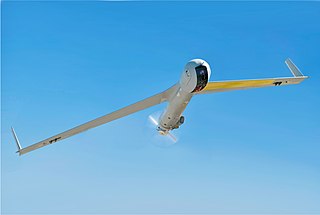
The Boeing Insitu ScanEagle is a small, long-endurance, low-altitude unmanned aerial vehicle (UAV) built by Insitu, a subsidiary of Boeing, and is used for reconnaissance. The ScanEagle was designed by Insitu based on the Insitu SeaScan, a commercial UAV that was intended for fish-spotting. The ScanEagle continues to receive improvements through upgrades and changes.
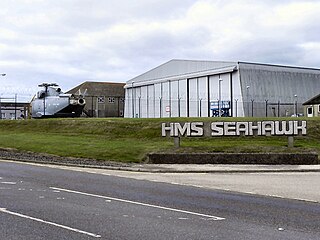
Royal Naval Air Station Culdrose is a Royal Navy airbase near Helston on the Lizard Peninsula of Cornwall UK, and is one of the largest helicopter bases in Europe. Its main role is serving the Fleet Air Arm's front line AgustaWestland Merlin helicopter squadrons.
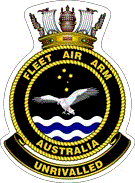
The Fleet Air Arm (FAA), known formally as the Australian Navy Aviation Group, is the division of the Royal Australian Navy (RAN) responsible for the operation of aircraft. The FAA was founded in 1947 following the purchase of two aircraft carriers from the Royal Navy. FAA personnel fought in the Korean War and the Vietnam War, and participated in later conflicts and operations from host warships.

700 Naval Air Squadron is an experimental test squadron in the Royal Navy’s Fleet Air Arm.

Marine Unmanned Aerial Vehicle Squadron 1 (VMU-1) is an unmanned aerial vehicle squadron in the United States Marine Corps that operates the RQ-21 Blackjack. They are based out of Marine Corps Air Station Yuma, Arizona and provide aerial surveillance for the I Marine Expeditionary Force. They fall under the command of Marine Aircraft Group 13 and the 3rd Marine Aircraft Wing.

Marine Unmanned Aerial Vehicle Squadron 2 (VMU-2) is an unmanned aerial vehicle squadron in the United States Marine Corps that operates the RQ-21A Blackjack. The squadron is based at Marine Corps Air Station Cherry Point in Havelock, North Carolina and provides aerial surveillance, offensive air support, and electronic warfare for the II Marine Expeditionary Force. VMU-2 falls under the command of Marine Aircraft Group 14 and the 2nd Marine Aircraft Wing.

The Schiebel Camcopter S-100 is an Austrian unmanned aerial vehicle (UAV) using a rotorcraft design.
Dr. Imraan Faruque is an American who is most known as a designer and author in the unmanned aerial vehicle (UAV) field. He is the designer responsible for a variety of UAVs, including several currently operational in Iraq, the most well-known being the R-series UAVs which are based on commercial airframes, along with work on Insitu's ScanEagle. These vehicles are normally deployed as a part of reconnaissance missions as they are unarmed but carry either a significant camera or FLIR unit.

Insitu Inc. is an American company that designs, develops and manufactures unmanned aerial systems (UAS). The company is a wholly owned subsidiary of Boeing Defense, Space & Security, and has several offices in the United States, the United Kingdom, and Australia. Their unmanned aerial vehicle (UAV) platforms—ScanEagle, and RQ-21A Blackjack have logged nearly 1 million operational flight hours as of February 2018.

The Arcturus T-20 unmanned aerial vehicle (UAV) is a medium range, fully composite aircraft capable of internal and external payloads. Launched from a portable catapult, it can be recovered with a shipboard landing system, or belly land on unimproved surfaces. The T-20 carries a retractable gimbal-mounted, digitally stabilized, electro-optical/infrared (EO/IR) camera that relays video in real time via a C-band LOS data link to the ground control station (GCS). Powered by a 4-stroke, fuel injected gasoline engine, the aircraft burns 2 lbs of fuel per hour at cruise. The T-20 does not require an airfield to operate and lands on dirt, grass, desert, or gravel roads. The internal payload bay (11"x11"x36") allows for sensor arrays to be pre-assembled on 'payload pallets' that attach from the bottom of the aircraft. The T-20 system includes three aircraft, ground control station, portable launcher, and support trailer for equipment and personnel. The airframe is entirely composite with complex wet wings tested to stresses of 10 G's.
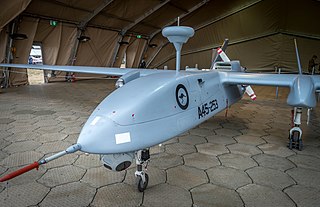
No. 5 Flight was a Royal Australian Air Force (RAAF) aircraft flight which was equipped with IAI Heron unmanned aerial vehicles. It was established in 2010 to operate Herons in Afghanistan. Following the withdrawal of the Heron detachment from that country in 2014, conducted training missions in Australia to maintain the RAAF's expertise in operating unmanned aerial vehicles until more advanced types are delivered. The Herons were retired in June 2017, and the flight was disbanded by the end of that year.
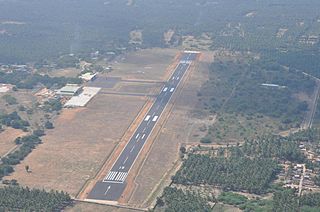
INS Parundu is an Indian naval air station located near Uchipuli in the Ramanathapuram of the state of Tamil Nadu. It operates under the Eastern Naval Command of the Indian Navy. The air station will be opened up for civilian flights under Phase 2 of the Regional Connectivity Scheme (RCS) of the Government of India also known as UDAN and the Airports Authority of India (AAI) has started preparatory work at the airstrip.

The Boeing Insitu RQ-21 Blackjack, formerly called the Integrator, is an American unmanned air vehicle designed and built by Boeing Insitu to meet a United States Navy requirement for a small tactical unmanned air system (STUAS). It is a twin-boom, single-engine monoplane, designed as a supplement to the Boeing Scan Eagle. The Integrator weighs 61 kg (134 lb) and uses the same launcher and recovery system as the Scan Eagle.

The GIDS Uqab is a tactical unmanned reconnaissance aerial vehicle built and developed by the Global Industrial Defence Solutions (GIDS) for the joint drone program of the Pakistan Navy and Pakistan Army. The Uqab is a tactical system which can be used for damage assessment, reconnaissance operations, artillery fire corrections, and can perform other variety of security and military operations.

The Italian Navy Aviation is the naval air component of the Italian Navy. Composed of around 2000 men and women and 69 aircraft and helicopters, the naval aviation represents a top niche and an enabler for the air-naval instrument.
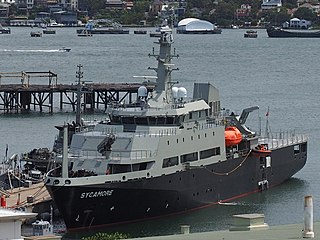
MV Sycamore is a training ship built to support the Royal Australian Navy (RAN) by Netherlands shipbuilders Damen Group. The vessel was built in Damen's shipyard in Haiphong, Vietnam and launched in 2016. The ship is operated for the RAN by Teekay Australia and entered service in 2017.

















